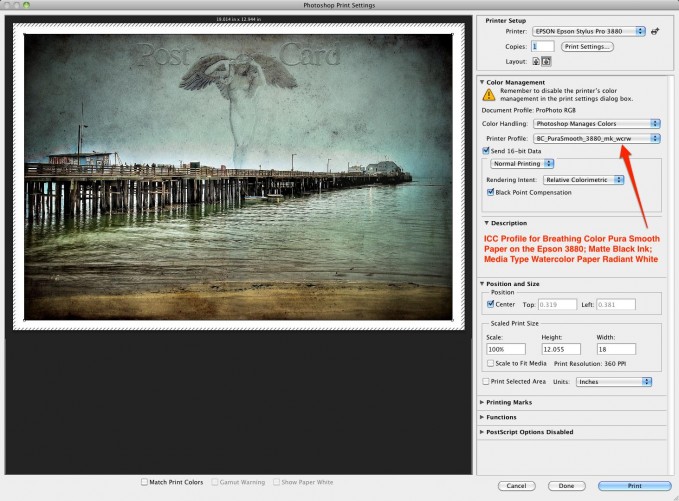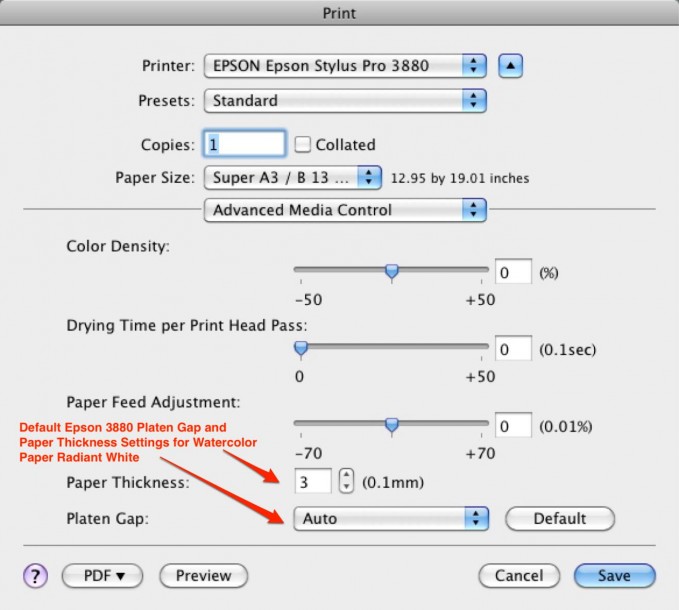

I confirmed that the print results didn’t change, but the feel in the hand was significantly better without the flexing. UPDATE: I did confirm that two of the three sample packs I had contained 10 mil Fibre Etching whereas the third contained 19 mil – which fills like the hot and cold press papers.

As a result, I think might have received a sample that was closer to 10 mil vs the final paper that is 19 mil. However, the sample provided by Epson using Vincent Versace’s print felt more solid like a 19 mil paper should. If you hold it at the edge it will flex down unlike Hot or Cold Press papers that stay rigid.

The texture and thickness of my sample paper felt much like Ultra Premium Presentation Paper Matte in that it is very flexible. This makes it more aesthetically pleasing paper with whites, yet it still retains the archival longevity of papers that do not have OBA’s. When holding the paper in my hand I observed that it is slightly brighter than Epson Velvet and much brighter than Hot Press Natural, despite the absence of OBA’s. On a Epson SureColor P800 In The Hands Analysis In fact, if you compare the color gamut as a 2d chart (from ColorThink Pro) against Cold Press Natural then you’ll see they are fairly similar:Įpson Legacy Fibre vs Cold Press Natural Color Gamut However, in practice the differences don’t feel that large. When comparing Fibre next to a variety of other Epson papers you’ll see that its color gamut isn’t quite as large as some of the others:Ĭold Press Bright & Natural, and Hot Press Bright and Natural If you aren’t a geek you might want to skip this section.

#EPSON 3880 PRINTER SETTINGS MEDIA TYPE BARYTA PAPER MANUAL#
That means that your Page Setup is wrong or that the wrong feed has been chosen (e.g., Velvet Fine Art Paper does not come in 4圆 and requires the Manual Feed). Choose relative and forget about this if you follow step 4. The enigmatic rendering intent for dealing with out-of-gamut colors (perceptual or relative) follows. Epson uses acronyms in its profile names (why I don’t know) so a cheat list is shown below. Click the pull down arrows and either choose a profile for your paper or “managed by printer.” (A blog entry on where to get these profiles and populate this list is here). What you choose here makes a big difference so choose wisely. You have to choose a paper profile, OR let the printer manage color. Now it is a bit tricky, so pay attention. Smart money says set the sharpening to Standard, and use Media Type Glossy when printing on glossy, luster, semi-gloss, an F-type or Baryta paper. The 3800 can accept 16 bit data check it here and in the print settings (step 8, below). Learn which ink your paper uses (Photo Black for glossy, Matte Black for matte) and batch the papers. This is also where you make the first choice as to media (second and third is coming up), which affects ink type to be used. Lots of reasons to do this (mainly because this is the native resolution of the printer). Set the print resolution to 360 ppi and forget it.


 0 kommentar(er)
0 kommentar(er)
